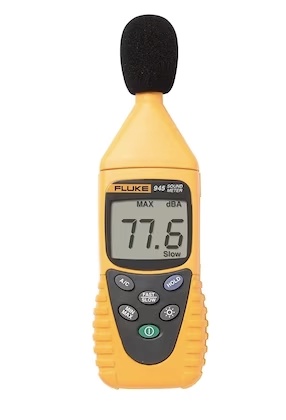A sound decibel metre, often called a sound level metre or noise metre, is a tool used to gauge how loud or intense a sound is. Decibels (dB), a logarithmic scale used to quantify relative loudness in relation to a reference level, are the units used to measure sound.
What you should know about sound decibel metres is as follows:
The main purpose of a sound decibel metre is to measure sound pressure levels and generate a decibel-based numerical value. It aids in quantifying sound intensity and determining whether it is within safe ranges or exceeds guidelines.
Sound decibel metres commonly measure sound levels between the ranges of 30 and 140 dB. From soft whispers to incredibly loud noises like jet engines, the range encompasses a wide spectrum of sounds.
A microphone that absorbs sound waves and transforms them into electrical impulses is a feature of a sound decibel metre. The accuracy of the metre as a whole depends on how well the microphone can detect sound coming from different angles.
Display: The measured sound level in decibels is shown on the digital display of the majority of sound decibel metres. The highest, minimum, and average sound levels over a given time period are additional details that some models also incorporate.
Frequency Weighting: To take into consideration the human ear's variable sensitivity to various frequencies, sound decibel metres frequently include frequency weighting filters. A-weighting (dBA), which roughly represents the most popular weighting, An additional aspect of sound decibel metres is time weighting. Because of this, the metre may modify how quickly it responds to various sounds. The two most common time weighting options are "Fast" and "Slow." In contrast to slow time weighting, which produces a more averaged reaction over time, fast time weighting produces a more immediate response.
Applications: Sound decibel metres are employed in a number of settings to measure and regulate noise levels. They are extensively used in businesses, building projects, amusement parks, airports, workplaces and residential settings. As well as helping in compliance with noise rules, they are helpful for environmental monitoring.
Standards and Regulations: A number of nations and organisations have created guidelines for the allowable levels of noise in various environments. To achieve these requirements, sound decibel metres are frequently calibrated. Advanced sound decibel metres may also include capabilities like data logging, real-time frequency analysis, USB connectivity for data transfer, and software integration for more thorough analysis.
It's important to remember that sound decibel metres must undergo routine calibration in order to function properly and provide precise and accurate values. A recognised reference source is compared to the meter's measurements during calibration, and any necessary adjustments are made.
Sound decibel metres are useful tools for managing noise levels to safeguard public health, preserve workplace safety, and reduce adverse effects on the environment.Sound Measurement: The main job of a decibel metre is to gauge the ambient sound pressure level (SPL). Through its built-in microphone, it records sound waves and transforms them into electrical impulses. Sound is measured using a logarithmic scale known as decibels (dB), which quantifies how loud a sound is in relation to a reference level. The decibel scale is logarithmic because of how the human ear perceives sound strength.
Sensitivity of the microphone: Decibel metres come with a microphone that has a certain sensitivity profile. The sensitivity of the microphone controls how well sound is captured and has an impact on measurement accuracy. Typically, the sensitivity is expressed in decibels (dB) re one volt per pascal (dBV/Pa).
Decibel metres include frequency weighting filters to take into consideration the human ear's variable sensitivity to various frequencies. The weighting that is most frequently used, A-weighting (dBA), simulates how a human ear would react to normal environmental sounds. In particular applications, other weightings like C-weighting and Z-weighting are also utilised.
Time Weighting: Decibel metres frequently provide time weighting settings to accommodate various sound patterns. There are two main time weightings: "Fast" and "Slow." Fast time weighting offers a quicker reaction, making it ideal for measuring transient or impulsive noises. For measuring continuous noises, slow time weighting produces a more averaged response over time.
Display and Readout: The display on decibel metres shows the measured sound pressure level in decibels. The display may additionally offer other details like the highest, lowest, and average sound levels for a given time frame. A graphical depiction of the frequency spectrum or other data may be provided on some metres.
Decibel metres have a predetermined range and a specific The lowest and greatest sound levels they can precisely measure are within the measurement range. Decibels are commonly used to express ranges, for as 30 dB to 130 dB. The lowest increment in decibels the metre can display, such as 0.1 or 1 dB, is referred to as resolution.
Calibration: Decibel metres need to be calibrated on a regular basis to ensure precise and trustworthy measurements. A recognised reference source is compared to the meter's measurements during calibration, and any necessary adjustments are made. The accuracy and traceability of the metre to recognised standards are maintained through routine calibration.
Applications: There are several uses for decibel metres. They are employed at workplaces, building sites, amusement parks, offices, residences, and environmental monitoring. They are essential in determining noise exposure, regulatory compliance, workplace safety, and analyses of the environmental impact.
Decibel metres provide precise sound level measurements that aid in identifying potential noise dangers, controlling noise exposure, and putting in place the necessary controls to safeguard public health and maintain a secure and comfortable environment.


No comments yet